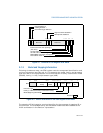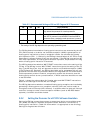
9-2 Vol. 3
PROCESSOR MANAGEMENT AND INITIALIZATION
The software-initialization code performs all system-specific initialization of the BSP
or primary processor and the system logic.
At this point, for MP (or DP) systems, the BSP (or primary) processor wakes up each
AP (or secondary) processor to enable those processors to execute self-configuration
code.
When all processors are initialized, configured, and synchronized, the BSP or primary
processor begins executing an initial operating-system or executive task.
The x87 FPU is also initialized to a known state during hardware reset. x87 FPU soft-
ware initialization code can then be executed to perform operations such as setting
the precision of the x87 FPU and the exception masks. No special initialization of the
x87 FPU is required to switch operating modes.
Asserting the INIT# pin on the processor invokes a similar response to a hardware
reset. The major difference is that during an INIT, the internal caches, MSRs, MTRRs,
and x87 FPU state are left unchanged (although, the TLBs and BTB are invalidated as
with a hardware reset). An INIT provides a method for switching from protected to
real-address mode while maintaining the contents of the internal caches.
9.1.1 Processor State After Reset
Table 9-1 shows the state of the flags and other registers following power-up for the
Pentium 4, Intel Xeon, P6 family, and Pentium processors. The state of control
register CR0 is 60000010H (see Figure 9-1). This places the processor is in real-
address mode with paging disabled.
9.1.2 Processor Built-In Self-Test (BIST)
Hardware may request that the BIST be performed at power-up. The EAX register is
cleared (0H) if the processor passes the BIST. A nonzero value in the EAX register
after the BIST indicates that a processor fault was detected. If the BIST is not
requested, the contents of the EAX register after a hardware reset is 0H.
The overhead for performing a BIST varies between processor families. For example,
the BIST takes approximately 30 million processor clock periods to execute on the
Pentium 4 processor. This clock count is model-specific; Intel reserves the right to
change the number of periods for any Intel 64 or IA-32 processor, without notification.
Table 9-1. IA-32 Processor States Following Power-up, Reset, or INIT
Register Pentium 4 and Intel
Xeon Processor
P6 Family Processor Pentium Processor
EFLAGS
1
00000002H 00000002H 00000002H
EIP 0000FFF0H 0000FFF0H 0000FFF0H
CR0 60000010H
2
60000010H
2
60000010H
2


















